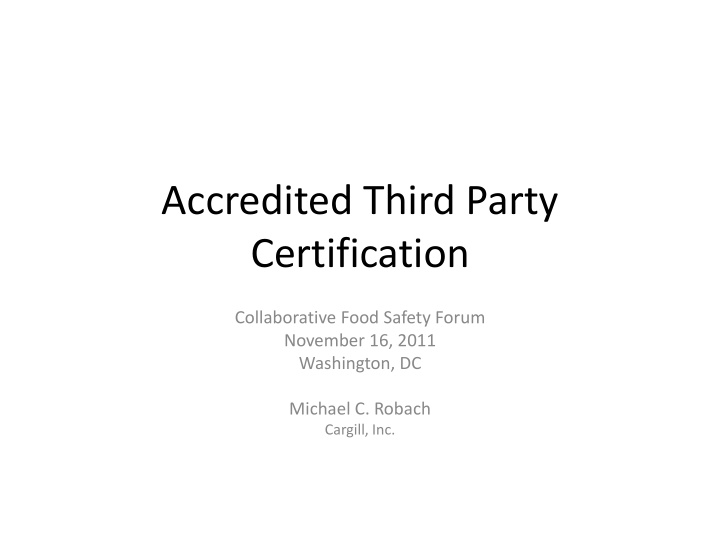



Accredited Third Party Certification Collaborative Food Safety Forum November 16, 2011 Washington, DC Michael C. Robach Cargill, Inc.
Third Party Accreditation – Key Messages 1) Certification by an accredited third party is an effective tool to assess food safety and is an important component of several FSMA mandates: Import Certifications, VQIP, FSVP. 2) For efficient use of resources, FDA should establish a system for the recognition of accreditation bodies that accredit third party auditors to certify food facilities, rather than directly accrediting third party auditors. 3) Certification should be performed by an independent (third party) organization that is accredited by a non-profit authoritative body ( i.e., accreditation body) that is a signatory to the Multilateral Recognition Arrangement overseen by the International Accreditation Forum (IAF). 4) Currently, this model is already in place for the most widely and internationally used food safety schemes, such as those recognized by GFSI ( e.g., FSSC 22000). 2
Background • In developing our recommendations, we reviewed FDA’s prior experience with third parties: – Aquacultured Shrimp Pilot : Developed in response to the President’s Action Plan for Import Safety (November 2007), and the call for development of voluntary third party certification programs for foreign producers that export to the U.S. – Manufactured Food Regulatory Program Standards: Developed for state and local food regulatory agencies to ensure equivalency in regulatory programs. – FDA Guidance for Industry: Voluntary Third Party Certification Programs for Foods and Feeds: Describes the general attributes FDA believes a certification program should have to provide quality verification of product safety. 3
Accredited Third Party Certification – Terms & Definitions International Accreditation Forum (IAF): Through the IAF Multilateral Recognition Arrangement (MLA), IAF helps ensure that all accreditation bodies are following the rules of accreditation and applying the standards to affirm consistent delivery of certification schemes. Members (national accreditation bodies) perform verification activities by peer review using ISO 17011 to ensure conformance to IAF membership rules. Accreditation Body (AB): An authoritative body that gives formal recognition of the competence of a certification body to provide certification services against a scheme or a standard. ABs ensure that certification bodies are subject to oversight using ISO 17021 or ISO Guide 65 (to be replaced by ISO 17065 in 2012). Certification Body (CB): An independent (third party) organization that conducts certification audits and provides written assurance of an audited food company’s conformance to a certain scheme or standard. A CB is accredited (by an AB) for its ability to certify a food facility’s conformance to a defined scheme or standard. Standard: Auditable and certifiable food safety requirements. Scheme: A standard plus a governance and management system to assure the integrity of the standard's delivery. 4
Recommended Required Elements for FDA’s Accreditation Program Recommended Required Elements: Supplier’s commitment to implement and sustain a food safety 1) management system in full compliance with FDA requirements 2) Compliance with regulatory requirements and alignment with international food safety and hygiene management standards 3) A systems-based approach to accreditation, with oversight of the Accreditation Bodies (must be IAF members) and Certification Bodies through conformity assessments 4) Transparency and independence of the assessment process (to ensure the integrity of the assessment process and results) 5) Impartiality and management of conflicts of interest, such as independence of the scheme from the CBs 5
Unaccredited Third Party Certification/Audit – Was common in US Potential Benefits to Industry: Cheap Quick Flexible Lacks: Audit Controls Oversight What (Std), How (Process), Who (Auditor) Transparency Independence Competition Credibility External Rules Site Food/Feed Safety System 6
“Accredited” Third Party Certification – But not IAF recognized Potential Benefits to Industry: Less expensive Says “Accredited” (what does that mean?) Flexible Lacks IAF external oversight Lacks: AB Oversight Accreditation Body Transparency Independence Certifying Body Controls Competition What How Who Credibility CB (Std) (Process) (Auditor) External Rules Certification Body Site Food/Feed Safety System 7
Accredited Third Party Certification – With IAF oversight IAF* ISO Benefits: Process & Rules Int’l Accreditation Forum Int’l Standards Org Transparency International (global) mutually SCHEME recognized system AB Standard + Mgmt System Accreditation Body (e.g., GFSI recognized schemes) Oversight Independence CB AUDITOR Certification Body Auditor Requirements Harmonized requirements for AB and CB (ISO standards) Site Food/Feed Safety 8 System
Accredited Third Party Certification – International Harmonization Global-to-Local Food Safety Systems Aligned with CODEX • Harmonization of food safety begins with science based CODEX C o u n t r y I n f r a s t r u c t u r e standards (the only standards 2 recognized by WTO & SPS Inspection & Compliance Laws & Regulations agreements) Nat’l to Local Regulations, Network of Labs & Inspectors Imports/Exports Verify Compliance • Country laws and regulations are 1 derived from CODEX; some use ISO International voluntary measures Governance CODEX- OIE-IPPC & WTO • ISO voluntary measures build on CODEX to facilitate trade. 163 Food Safety ISO GFSI countries develop transparent Management Systems Voluntary processes (accreditation, Capacity Building, Accredited Certification, 3 Measures Benchmarked Systems Transparency certification, auditing, competency) 4 International Organization Business Initiatives • GFSI benchmarked schemes build for Standardization on CODEX and ISO 9
Recommend
More recommend